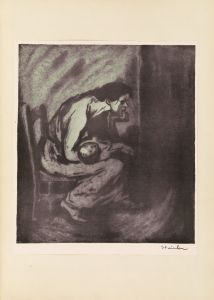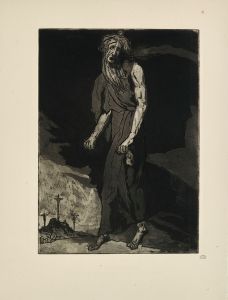
Soul in Bondage
A hand-painted replica of Elihu Vedder’s masterpiece Soul in Bondage, meticulously crafted by professional artists to capture the true essence of the original. Each piece is created with museum-quality canvas and rare mineral pigments, carefully painted by experienced artists with delicate brushstrokes and rich, layered colors to perfectly recreate the texture of the original artwork. Unlike machine-printed reproductions, this hand-painted version brings the painting to life, infused with the artist’s emotions and skill in every stroke. Whether for personal collection or home decoration, it instantly elevates the artistic atmosphere of any space.
"Soul in Bondage" is a painting by the American artist Elihu Vedder, created in 1891. Vedder was a prominent figure in the American Symbolist movement, and his work often explored themes of mysticism, mythology, and the human condition. "Soul in Bondage" is a compelling example of his interest in these themes, reflecting the artist's fascination with the metaphysical and the spiritual struggles of humanity.
Elihu Vedder was born on February 26, 1836, in New York City. He spent much of his career in Italy, where he was influenced by the classical art and architecture that surrounded him. Vedder's work is characterized by its allegorical content and often features dreamlike imagery and symbolic elements. He was part of a broader movement of artists and writers in the late 19th century who were interested in exploring the unseen and the mystical aspects of life.
"Soul in Bondage" depicts a figure in a state of confinement, symbolizing the struggle of the human soul against the constraints of the material world. The painting is rich in symbolism, a hallmark of Vedder's work, and invites viewers to contemplate the nature of freedom and the spiritual challenges faced by individuals. The use of light and shadow in the painting enhances the dramatic tension, highlighting the contrast between the physical and the spiritual realms.
The painting reflects Vedder's interest in the philosophical and the esoteric, drawing on a variety of influences from classical mythology to contemporary spiritual thought. His work often incorporated elements from different cultural and philosophical traditions, creating a unique visual language that resonated with the Symbolist movement's emphasis on expressing the ineffable and the transcendent.
"Soul in Bondage" is part of Vedder's broader body of work that includes paintings, illustrations, and writings. He is perhaps best known for his illustrations for the 1884 edition of "The Rubaiyat of Omar Khayyam," which brought him significant acclaim. These illustrations, like "Soul in Bondage," are characterized by their intricate detail and symbolic depth.
Vedder's work, including "Soul in Bondage," has been exhibited in various museums and galleries, reflecting his enduring influence on American art. His paintings are held in several prominent collections, and his contributions to the Symbolist movement continue to be studied by art historians and enthusiasts.
In summary, "Soul in Bondage" by Elihu Vedder is a significant work that exemplifies the artist's engagement with themes of spirituality and the human condition. Through its symbolic imagery and evocative composition, the painting invites viewers to reflect on the nature of the soul and its struggles within the confines of the material world.


















